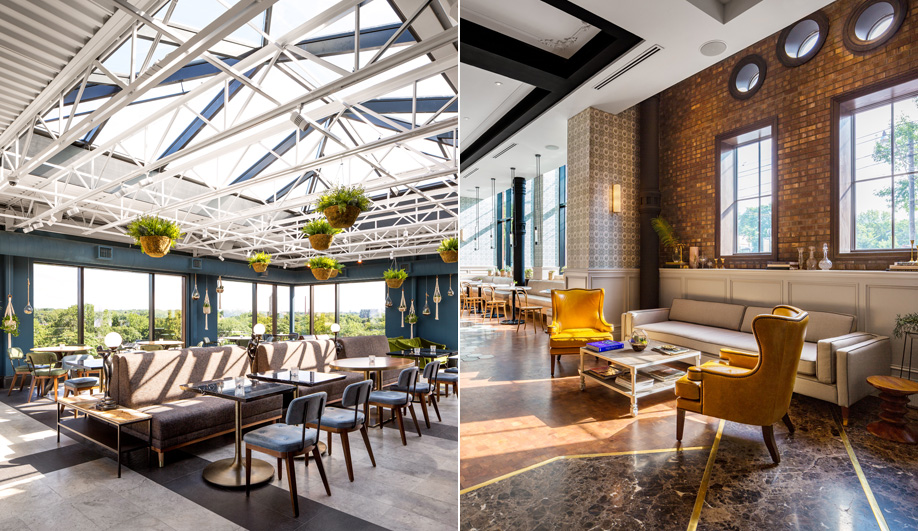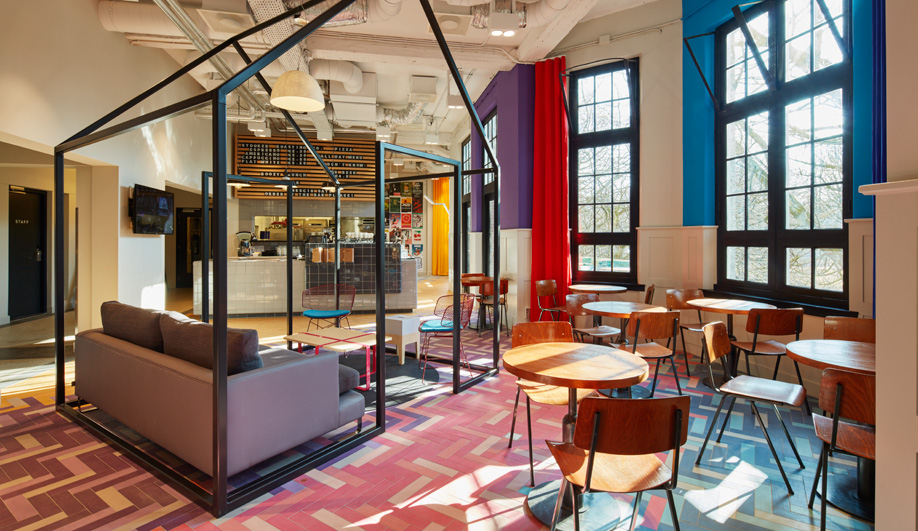
How a longtime friendship turned into DesignAgency, the go-to interior firm for hotels and restaurants seeking ready-made character and warmth.
The red brick Romanesque building at the intersection of Toronto’s Queen Street East and Broadview Avenue has witnessed more than its share of dancers over the years, many in varying states of undress. Since 1891, it has lived multiple lives as a commercial hub, a meeting hall and, intermittently, a hotel. In its most recent incarnation as a boarding house and home to the strip club Jilly’s, it held firm as a shabby east end cornerstone while everything around it gentrified. It is safe to say that, up until last night, it had never had Grace Jones and Fashion Santa share the dance floor.
In 2014, when the club’s owners ordered an interior teardown so they could improve sightlines for customers, they inadvertently removed essential structural walls, and, in an instant, the building was condemned. Not much later, Streetcar Developments decided to buy and renovate it into the Broadview Hotel, and they brought in ERA Architects to oversee a $25-million restoration. Then, with the aim of transforming the building into a landmark, they turned to DesignAgency to remodel the interiors and bring an all-encompassing approach to the element of hospitality.

It is fair to say that the five-storey hotel, open since July, is an instant success, especially its rooftop terrace that offers impressive views of the city skyline and of Lake Ontario. I’ve come to the hotel, during its soft launch, to reflect on how DesignAgency has grown as a firm, from its start as three friends (Allen Chan, Matthew Davis and Anwar Mekhayech), past a stint in reality television, to a studio with global reach, a staff of 40, and a client list that includes Momofuku and the Generator hostel chain. As we sit in the new Riverside bar, they tell me the Broadview is their ideal project, where they can get their hands on every aspect of its life, including how the building serves the community.
“We started programming the space before we even got into design details,” Davis tells me. “We asked ourselves, How is this space going to function; how is it going to be successful as a hotel? The community needs something that’s going to have a lasting presence.”
The resulting 58-room hotel is quintessential of DesignAgency’s later work, and a long way from the firm’s early days of flashy nightclubs: luxurious, elegant and already somehow effortlessly aged into itself. Like another one of the firm’s local projects – the private Soho House club – the Broadview has an understanding of how people will actually sink into a space and make it their own.

Here in the hotel café – where custom leather-seated stools line a Breccia Capraia marble-topped bar, and chairs from TON surround tables by Coolican & Company – the DesignAgency team members point me to playful signs of the building’s colourful past: The wallpaper, from Rollout, is created from the patterns they found beneath the layers during demolition, and a curvaceous neon installation hanging over the bar, designed in collaboration with Chicago artist Erik L. Peterson, was fabricated by the son of the creator of the original Jilly’s sign. In the lobby, where a feature light from Anony hangs over an imposing custom brass reception desk, the cladding around the elevator is formed from remnants of the old fire escape.

After nearly two decades of working together, the members of the trio see their roles as fluid. Mekhayech is the one quickest to jump to the bottom line, but the creative spark is in all three. When he won a bid to open a restaurant at the University of Toronto back in 1998, Mekhayech liked the idea of working on its interiors with his friends, and so Precipice Studios came into being alongside sPaHa, the company’s first collaborative project.
“For me the whole point was design as business,” Mekhayech says. “We genuinely thought there was something happening in the design world. Thinking back, we didn’t really discuss our name or our brand values, it was just go.” Their partnership began with four desks in a warehouse space, Chan still studying, Mekhayech mostly busy with the restaurant. “You’re right out of school and you think you can conquer the world,” says Chan. “We started with that approach, and we did a lot of work trying to get work without really a plan or a strategy. We were just doing things that we liked to do.”
That meant mostly designing restaurants and nightclubs during the early aughts, at a time when interior design was all about making big statements and inserting gimmicks that would have patrons talking about the cool clubs with friends the next day. The Guvernment along Toronto’s waterfront, for instance, featured a hydraulic D.J. lift five metres tall and the largest LED wall in North America, which bathed dancers in a colourful light show.
Their local cachet grew along with the commissions, and in 2005 they became hosts of Designer Guys, a reality show that gave them ample opportunity to try out any idea they could dream up. It was the ultimate training ground, though not one they rush to bring up these days.

Throughout our conversation they return to the value of good P.R. As a company, they make no claim to a single aesthetic. As Chan explains, their early focus was on developing an approach that was new to their market, and habitually over-delivering on research, going beyond commissioned briefs. “We did things that clients didn’t know they needed but really valued,” he says. “It was about a bigger picture of how the overall project would work, and how the programming of all those elements and the master planning fit together.”
“We weren’t selling it to them though, that’s the problem!” Mekhayech cuts in. “We were giving it away for free.” Throughout its first decade, the company stayed small. It took on a few staff, losing some from time to time when downsizing was needed. The partners – industry outsiders but sociable ones – learned from others who were willing to share. They point to guidance from the likes of Yabu Pushelberg and Quadrangle, with whom they shared office space during the 2008 recession. “I think talking to people and getting indirect mentorship always helped us along the way,” Mekhayech says. “It led us to hiring people to help us think about how to help ourselves.”
About 10 years in, the partners decided to liberate themselves from Precipice Studios to become the aggressively generic studio The Design Agency (later DesignAgency). “We wanted to almost arrogantly be the Canadian design agency,” Mekhayech says. Just as the reality show was wrapping up in 2008, Mekhayech met New York hotelier Josh Wyatt, who was starting up Generator, a revolutionary reinvention of the hostel concept.
They met at a charity party via a friend of a friend (basketballer Steve Nash) and got to chatting about their shared interest in luxury hospitality. “Josh had taken a year off to travel, and he came up with this idea about how to bring design into the budget lifestyle travel space,” he says. Some time later, a phone call came – Wyatt had just bought a hostel company, and could they come to Dublin, like, right now to help realize his concept. “From that point forward, we really helped create that brand through its evolution,” Mekhayech says. “We ended up being the constant.”

They have now worked with Generator on 11 locations in almost as many countries, in what Wyatt compares to a long-term relationship that has moved well beyond its early phase of infatuation. “From concept to completion, they were able to stay the course,” he tells me. “The ability to reinvent themselves on each of these projects and actually be distinctive is what drove the repeated business I gave to them over the years.”
This year, the chain was sold to a private equity firm for €450 million ($660 million), after posting €70 million ($106 million) in revenue in 2016. But at the outset, there was no existing model to copy – it was an entirely new category, catering to an emerging set of internationally mobile working nomads. “Since there was no benchmark to look at, you start looking upwards,” Davis explains. “So, we would look at what the best boutique hotels were doing and what’s making them successful. We’d then take that study and apply it to a bracket that just doesn’t have access to those social spaces.”
Much of DesignAgency’s subsequent work has been with established brands – Soho House, Momofuku, Nando’s – brands that already have reputations and guidelines. I ask Mekhayech what the likes of Momofuku get from a relationship with a mid-size Toronto firm. “The interesting thing with those brands is that they’re constantly evolving,” he explains. “They’re looking to become more effective as a brand. Some want a cookie cutter and that’s fine. For their first noodle bar space in New York, we weren’t involved in that process, but now there are ramen shops all over the world that have the same look. They’re a perfect example of a brand that’s constantly evolving. There’s a real opportunity to take them on that journey.”

Later I ask David Chang, chef and founder of Momofuku, about this new experience of working with a consistent design team across multiple projects, including one in Las Vegas. “We speak a common language now,” he tells me. “It allows us to improve on each project without having to reinvent the wheel. Historically, we never spent money on our restaurants outside of the kitchen. But DesignAgency has provided us with thoughtful interiors that still allow the guests to focus on the food.”
As the business has matured and work has spread to outpost offices and faraway clients, the partners spend their lives almost perpetually on planes. They’ve made a raft of operational decisions to keep things sane, including hiring a front-of-house manager and building a dedicated operations team. At least one of the partners remains hands-on on any given project, but they now cede a little more territory to design directors. Many of these changes were overdue, they say.
“We were all over the map three or four years ago,” Chan says. “Looking back on it, it’s like, wow, how did we ever survive without this support? Obviously now that we’re working on the business and not in the business as much, part of that mindset has to be, How can you do a project of this size or larger and not totally blow yourself away?”
Though the partners feel they now have a healthy office culture, they admit they face a challenge adapting to the work and lifestyle expectations of the next generation. They were upstarts themselves once; now they’re the establishment. “We’re listening,” says Chan. “In Toronto there’s so much competition for talent that people are like, if it doesn’t work I can go somewhere else. What is the laundry list of things you need to do to attract talented staff and retain them?”
From the Broadview’s rooftop, the spectacular city view is full of cranes and scaffolds. Over the course of DesignAgency’s life, this landscape has changed beyond recognition. As we discuss upcoming work with Marriott, Momofuku and SBE, and on the 2019 expansion of Toronto icon the Drake Hotel, Davis asks me to look the other way, toward the east – there, the big city gives way to single storey houses and the trees and ravines of the still-wild fringes. There’s a lot more still to come.
This story was taken from the November/December 2017 issue of Azure. Buy a copy of the issue here, or subscribe here.
